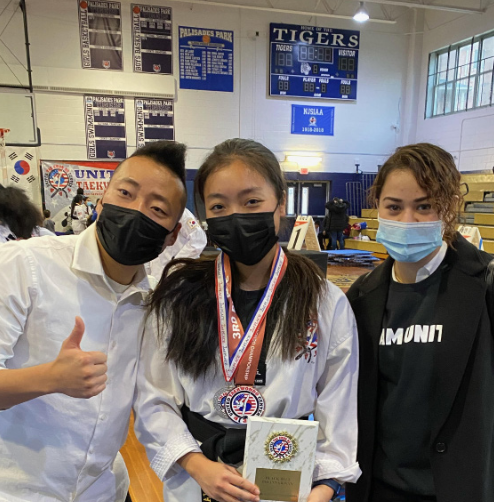Obscure Sports: The Lessons of Taekwondo

February 16, 2023
Did you know that after a long day of school and a two-hour sports practice there are Poly students who practice Martial Arts after that? Poly is known for its diverse opportunities in athletics, but some choose to pursue sports that aren’t offered at school. Senior Brianna Kwan, a longtime member of the Poly track team, has practiced Taekwondo up to six times a week every single week for the past five years.
Kwan is a dedicated athlete and has been practicing Taekwondo and mastering a multitude of techniques and forms since the 7th grade. Kwan began her Taekwondo journey one day in middle school while trying to escape her boredom at home. After hours of being unproductive, her mother suggested she checkout the nearby Taekwondo dojang. That day, she started practicing at United Taekwondo Center Bensonhurst in the Dyker Heights area, learning from Master Seo.
“After the first two trial classes, I was immediately hooked and saw the dojang not as a business, but a family. It’s safe to say self-defense is not the only thing I’ve learned from Taekwondo—I have many backup plans in the case of a real fight,” Kwan said.
Kwan has uncovered many uses for Taekwondo besides having fun including: learning respect, discipline, and self-defense in case of an emergency.
After her first three years of intense Taekwondo, Kwan earned her black belt. Typically, three years is a short amount of time to earn such a respected title. However, through Kwan’s dedication and consistency, she was able to acquire this achievement sooner than the average student.“I don’t really think it matters how long it takes someone to earn their black belt—whether that’s 2 or 5 years. It just matters how much effort you put into your training and whether or not you can do the kicks, forms, and spar well,” Kwan said.
Kwan promotes a positive and productive atmosphere besides the physical combat. “Taekwondo is a form of martial arts and so there is a level of respect that has to be learned as a part of the art. Everything one does has to be intentional and the unspoken rule is to always respect someone of a higher belt no matter the age. Even when you speak, you have to end your words with ‘Ma’am’ or ‘Sir’.” Taekwondo is also an art form, which unveils a different side to competition.
Along with her weekly practices, Kwan participates in a couple of competitions per year.
“Competitions usually happen in the spring or fall, and are usually 1-2 per season. They happen in public school gyms, as only they are large enough to hold over 200 people with multiple areas sectioned off for different ranks and competition types,” Kwan said.
Taekwondo has a unique scoring system. Players must compete in three rounds. Each round lasts one minute long and points are earned by hitting their opponents chest and head gear. A strike to the head earns three points, strike to the chest gear earns two points, and a punch to their chest gear earns one point.
Kwan’s love for the familial environment keeps her dedicated to practice every week. “Whenever I’m at practice, I forget everything about school and life and just get in the zone to do whatever has to be done. The community is always very easygoing and full of energy. Although we may want to knock each other out during sparring practices, it’s out of love by giving your opponent a realistic sparring round.”
Her love for the sport extends from competition to the mentality that relieves her everyday stress. Kwan hopes to continue practicing this art in future years and take her Taekwondo skills to the next level. She plans on participating at the collegiate level and possibly expand her Martial Arts capabilities to other forms such as Muay Thai. Kwan believes that everyone would benefit from the cultural aspect of martial arts through hard work and discipline.
























